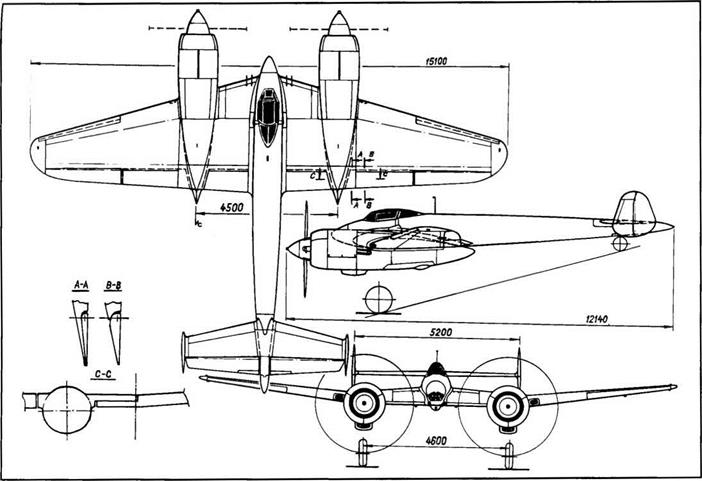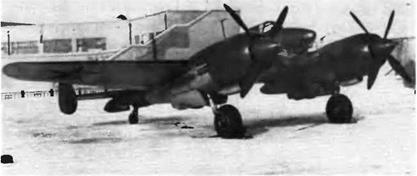DIS 200 / IT
Because neither Charomskii diesels nor Mikulin AM-37 engines were ready for use, the DIS-200 second prototype was powered by an M-82F, a mass-produced radial engine that could afford 1,250 kW (1,700 ch) at takeoff and 957 kW (1,300 ch) at 6,500 m (21,300 feet). The aircraft – built in Kuybyshev, where factory no. 1 and the OKB had relocated in October 1941 — was first called the IT (factory code).
Both T and IT prototypes had the same structure. The only difference, except for the engines, concerned the heavier armament: four 7.62-mm ShKAS and two 12.7-mm BS machine guns plus two 23-mm VYa-23 cannons. The T could carry either a 1,000-kg (2,200-pound) bomb or a torpedo of the same weight, depending on mission requirements. The IT rolled out of the factory in January 1942 and made its first flight later that month with G. M. Shiyakov (an LII pilot) at the controls. It was then transferred from Kuybyshev to Kazan, where it was test-flown. Meanwhile, the experience of the war demonstrated that escort missions could be handled successfully by frontal fighters, making the development of a special type of aircraft unnecessary. The IT flight tests were consequently terminated.
|
DIS-200 (IT) (MiG О KB three-view drawing) |
|
The DIS-200 (IT) or DIS-2M-82F was the second and final prototype of this program. Because long-range escort fighters were no longer needed, flight tests were terminated in 1942. |
Specifications
Span, 15.1 m (49 ft 6.5 in); length, 12.14 m (39 ft 9.9 in); height, 3.4 m (11 ft 1.8 in); wheel track, 4.6 m (15 ft 1.1 in); wing area, 38.9 m2 (418.7 sq ft); takeoff weight, 8,000 kg (17,630 lh); fuel, 1,920 kg (4,230 lb); wing loading, 205.7 kg/m2 (42.11 lb/sq ft).
Performance
Max speed, 604 km/h at 5,000 m (326 kt at 16,400 ft); climb to 5,000 m (16,400 ft) in 6.3 min; service ceiling, 9,800 m (32,140 ft); range, 2,500 km (1,550 mi).












